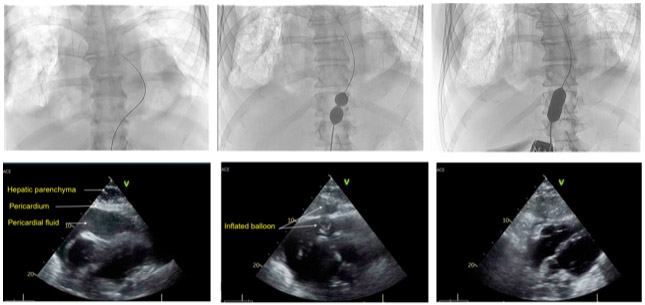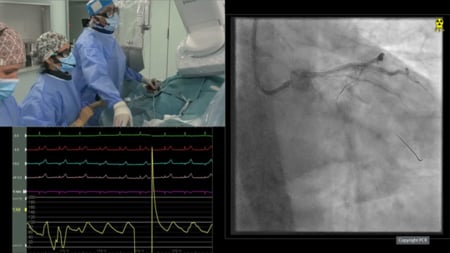Percutaneous pericardiotomy for recurrent malignant pericardial effusion
#CardioTwitterCase originally published on Twitter
This is a step-by-step description of safely performing a percutaneous pericardiotomy.
This case was originally published on Twitter by @drvishalg
Case description
Pericardial windows are indicated for recurrent symptomatic pericardial effusion, a large portion of which are malignant and in frail patients. A percutaneous option would be highly desirable in this patient population.
We present the case of a 58-year-old Caucasian male patient with metastatic head and neck squamous cell carcinoma, presenting with cardiac tamponade, who successfully underwent a percutaneous pericardiotomy.
The pericardial space was accessed utilizing real-time ultrasound guidance, and an 18 G needle via the subcostal window, after local anesthetic infiltration of the entire track. An Amplatz extrastiff 0.035” wire was inserted in the pericardial space under fluoroscopic guidance, a 1 cm skin incision was made, and the track was dilated using a 9F dilator. A 45x20 mm True balloon was positioned in the pericardium, partially inflated and pulled back to mark the pericardial-mediastinal transition. The True balloon was then pulled back into the hepatic parenchyma and inflated to 2 ATM while watching for the resolution of the balloon waist that localized the pericardial transition (Figure 1).

The balloon was removed and an 8 F pigtail catheter was inserted, with removal of 550 mL of bloody pericardial fluid; till there was no further drainage. All equipment was removed at the end, while the patient was asked to breathe out and a pressure dressing was applied.
Final remarks
In conclusion, percutaneous pericardiotomy is a minimally invasive alternative to a surgical pericardial window in patients with recurrent symptomatic pericardial effusions.
Original tweet and Twitter discussion
Who wants a window! Percutaneous Balloon Pericardiactomy (PBP)
— Vishal Gupta, MBBS, MPH, FACC, FSCAI (@drvishalg) April 30, 2023
Very simple and effective - Thanks @IgorPalacios3 for teaching this to us.
- Sub xiphoid approach
- Amplatz stiff wire
- 20x40mm ZMed or True
- 2min inflation#pericardium#pericardial_effusion#PBP#CardioTwitter... pic.twitter.com/SnpbNlyqcp
Authors






No comments yet!